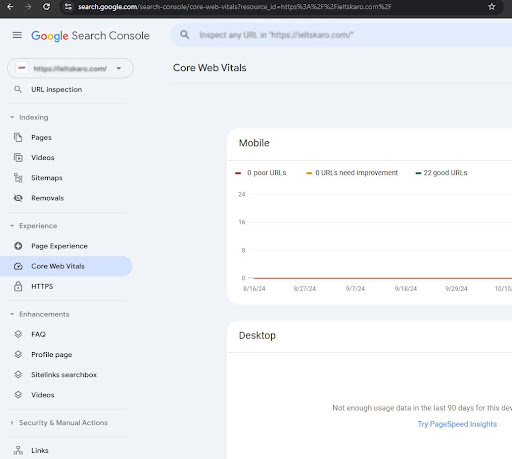Did you know that Google uses over 200 factors for ranking websites? While it is not humanly possible to work on all 200 of these, there are a few really important ones we will be discussing herein.
In this guide, we will be exploring how the rise of AI, core web vitals, website speed test, content relevancy and voice search are all going to change the SEO landscape in 2025.
Key takeaways:
- Core Web Vitals are now a part of Google’s ranking factors.
- Writing structured content only for rankings, may lead to penalties.
- Focus on generating quality content on search intent to fill the information gap.
- Google now prioritizes page speed and user experience.
- High-quality, original content is still the king that dominates search results.
What are Core Web Vitals and Why Are They Really Important?
According to the Google Search Central Developer Documentation, Core Web Vitals is:
A set of metrics that measure real-world user experience for loading performance, interactivity, and visual stability of the page.
The three Core Web Vitals are:
- Largest Contentful Paint (LCP) – This metric measures how quickly your website starts loading and displaying the main content. Ideally, this should not exceed 2.5 seconds.
- Interaction to Next Paint (INP) – This metric measures how responsive your site is to the actions that a user takes. In short, it measures interactivity. If you have a well-optimized and responsive site, this time should not exceed 200 milliseconds.
- Cumulative Layout Shift (CLS) – This metric measures visual stability, which points out to the unexpected shifts in user interactions. This should be less than 0.1.
Here’s how you can check your website’s Core Web Vitals through Google Search Console:

How Do Core Web Vitals Impact Rankings?
How well your website responds to the end users is what Google considers now to be an important ranking factor.
Visitors are more likely to spend time and convert to customers if your page is well-optimized, fast, and fulfills Google’s core web vital metrics. By focusing on effective local SEO strategies, you can increase your visibility in specific geographic areas where your target audience is located.
So let’s understand how each of these metrics impact page ranking.
Largest Contentful Paint
LCP shows how quickly your page’s main content loads up. The following elements comprise of the loading time for LCP:
- Images
- Image tags
- CSS
- Large blocks of text
You can use Google PageSpeed Insights to test core web vitals and diagnose performance issues.
If your LCP is:
- Less than 2.5 seconds – Your page has a fast loading time. (Green)
- 2.5 to 4 seconds – Page needs further optimization. (Orange)
- More than 4 seconds – Page load time is extremely poor and needs immediate attention. (Red)
Google also shows LCP data for all of your web pages, so that you can focus and start improving them one by one.
Cumulative Layout Shift
CLS measures any unexpected or sudden movements when your page loads. Visitors will get confused when the order of elements on your web page keeps changing. A healthy score to target is less than 0.1.
If your CLS score is:
- Less than 0.1 – No sudden changes in layout.
- In between 0.1 and 0.25 – Website visitors are able to notice a significant amount of shifting in the page content once it loads.
- Over 0.25 – You need to redesign or fix the entire layout as there are far too many sudden movements in the content, such as big texts and buttons appearing out of nowhere. This deteriorates user experience and severely affects your rankings.
Interaction to Next Paint (INP)
INP is the latest Core Web Vitals metric to replace First Input Delay (FID) on 12th march, 2024.
It measures how quick your website is in responding to the interactive elements. INP tracks, measures and then assigns a score in terms of user interaction. This number is in milliseconds.
So let’s suppose a visitor lands on your page, zooms in on a map, submits a form, and clicks a button. INP measures the time from the first interaction (zooming on a map) up to the last interaction (clicking a button).
If your INP score is:
- 200 milliseconds or less – All interactive elements are responsive.
- In between 200 and 500 milliseconds – Improve the interactive elements.
- Over 500 milliseconds – There are multiple glitches and lags when users interact with your site. Fix them to improve user experience
That’s why it is critical to have a reliable web host that exceeds all benchmark tests for core web vitals.
So What Can You Do To Improve Your Core Web Vitals?
Streamline the code by removing unnecessary third-party scripts. Third party scripts put extra load on the web server. Do not have more than the required scripts to run your page smoothly.
Migrate to a reliable and faster web host. Better hosting leads to faster load times, boosting the overall user experience, thereby positively impacting your core web vitals.
CSS, JS and uncompressed images will easily choke up your website, and before you even know it, visitors will bounce off as if they never arrived. Make sure to use services like Minifier and TindyPanda to compress the code and multimedia content to reduce page load time.
These suggestions will help you to dramatically boost your site speed for all three metrics of core web vitals.
So Is Having Excellent Page Experience Enough?
Yes, and no. Yes, because you need to provide the best possible user experience. No, because it isn’t the only ranking factor. There are hundreds of factors that Google takes into account for ranking a website, and page experience is just one of them.
Needless to say, if your well-optimized website is neither helpful nor relevant to your users, you will struggle in organic rankings.
That’s why quality content remains vital. Whether you run a WordPress blog or an ecommerce website, you can never achieve your targeted ranking without consistently publishing quality content that is helpful for your audience.
So instead of writing well-structured content for search engines, it is time to write for your visitors. This was the target of the mid-2022 Helpful Content Update by Google, which has now become a part of the March 2024 Core Web Vitals.
Write helpful, authoritative and informational content that puts you in the limelight. Develop topical authority so that Google considers you an expert in your field and rewards you with better rankings and traffic.
Write content that shows Google you have EEAT (Experience, Expertise, Authoritativeness and Trustworthiness). For example, we want our resources such as blogs, case studies and white papers to be an ultimate representation of our experience and trustworthiness in the cloud hosting industry. When a visitor reads our content, we would ultimately want them to trust us as experts in our field.
Similarly, you have to build this trust with your audience in your field by constantly publishing textual and video content that demonstrates your excellence in the industry.
Remember that whatever you do has to eventually help your target audience, not search engines.
Why Site Speed Matters More Than Ever?
The digital landscape has everyone racing for views, clicks and leads, resulting in revenue for their business. But all of this boils down to one thing; how quickly does your site open up to your users. That’s because users’ patience is waning. In an age of high-speed internet, slow sites will have no room to compete in 2025 and beyond.
A 2023 study found that websites loading in under 3 seconds experienced 32% lower bounce rates than slower sites. What’s worse? You lose 90% of the traffic when this load time shoots up to 5 seconds.
For e-commerce websites, a delay of even 1 second can lead to a 7% reduction in conversions.
Rapyd Cloud provides a reliable foundation by offering advanced caching, CDN integration, and quick-loading server infrastructure. This minimizes server response time, ensuring your website stays competitive in Google’s speed-driven algorithm.
But it isn’t just limited to Google. People shouldn’t suffer with slow page loading speed when they already have great options. The quality of your hosting provider is no longer just a convenience—it’s a necessity. Hosting affects load time, uptime, and user experience, all of which play a vital role in SEO.
Faster server response times directly improve LCP and user satisfaction leading to better user experience. While downtime can severely impact rankings and user trust, at Rapyd Cloud, we provide an iron-clad 99.99% uptime guarantee.
Why Go For a Mobile-First Index?
With over 60% of searches conducted on mobile devices, Google’s mobile-first indexing has made mobile performance a priority. Gone were the days when a website was designed for desktop, and then redeveloped for smartphones. Today, it is the exact opposite.
If a website isn’t responsive, you may lose a big chunk of your audience. Always ensure the website layout adjusts seamlessly to different screen sizes.
How AI Tools and Algorithms Are Reshaping the Landscape?
Artificial intelligence (AI) is transforming SEO by enhancing search engine algorithms and automating data analysis.
Google and Bing now leverage the power of AI in their search results. Let’s say if you were to do a quick Google Search on “What are core web vitals?”, here is how the search results will appear:
And here are the search results for the same query on Bing:
You can see how both search engines are using AI to generate meaningful summaries and content, which will immediately help the users with the right information.
This means that keyword stuffing and over-optimization have already become obsolete. Instead, AI favors content that matches user intent with high relevance and natural language flow.
For that reason, effective local keyword research is needed to ensure the content resonates with the specific needs of target audiences in different geographic areas.
According to a Hubspot survey, digital marketing professionals use a number of AI tools for content creation, with most of them utilizing chatbots (53%).
Search engines and brands have already started taking the help of Generative AI, and it is time you do the same too.
SSL, Security, and SEO in 2024
Cybersecurity is becoming a nightmare for website owners. According to a report, there are 97 victims of a cyber crime every hour. Security has always been a ranking factor, but Google’s emphasis on SSL certificates and HTTPS in 2024 highlights its importance.
Sites lacking SSL certificates are labeled “Not Secure,” which impacts both user trust and ranking potential.
All of our hosting plans come with a host of security features, which include:
- Free SSL Certificates
- Advanced DDoS Protection
- Vulnerability Scanning
- Bot Protection
- Malware Removal
- 24/7 Real-Time monitoring and mitigation of threats
SSL certificates also help in protecting confidential user information such as bank details, credit card numbers, name, DOB and residential address.
Read More: TLS vs SSL
What Are The Technical SEO Trends to Watch in 2025?
Alongside Core Web Vitals and hosting, a few key technical SEO trends stand out in 2025:
Structured Data
Google’s AI relies on structured data to understand website content. Implementing schema markup for products, reviews, and events helps search engines accurately interpret and display content.
You should also structure your content in headings, embedded videos, infographics and images to make it more appealing and engaging for your audience.
Server-Side Rendering (SSR)
SSR enhances SEO by delivering fully rendered pages to search engine crawlers. This setup is ideal for websites with heavy JavaScript usage.
Content Delivery Networks (CDNs)
CDNs reduce load times by delivering content from the server closest to the user. Using a CDN can improve both speed and reliability, making it a key investment for any site focused on SEO.
We have designed our managed WordPress hosting solutions for your peace of mind.
Wrapping it all up
In 2025, SEO will no longer be just about backlinks and keywords. Instead, it will be a complex mixture of user experience, content quality, relevancy and speed. AI-based search results, mobile-first indexing and the Core Web Vitals are all shaping up the SEO landscape. It is time that you stay ahead of the market trends and consider your website more like a digital asset.
Remember, your goal should be to provide the best possible user experience while delivering quality content that solves real-world problems.




